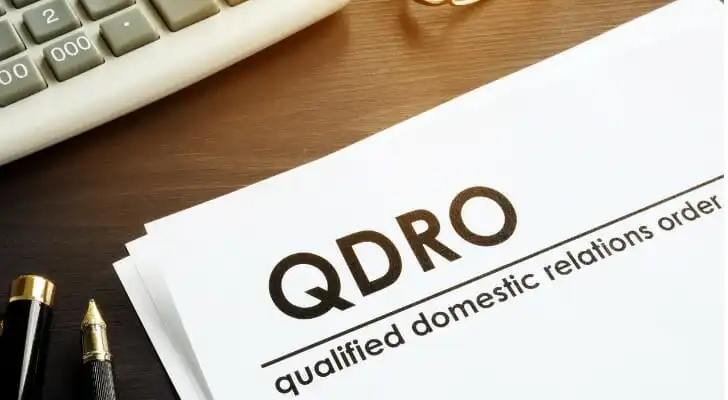Not to be confused with a divorce decree or property settlement, a qualified domestic relations order (QDRO) specifically recognizes an ex-spouse’s, or soon-to-be-ex-spouse’s, interest in the other spouse’s qualified retirement plan. A QDRO can also recognize the rights of the plan participant’s children or other dependents. A state court or authority issues a QDRO, but a retirement plan administrator can reject it if its requirements do not agree with the plan’s rules. This is why it’s important to submit a QDRO to a retirement plan administrator as soon as possible and ideally before a divorce is final. A financial advisor who specializes in divorce can help you with a QDRO.
How a Qualified Domestic Relations Order Works in a Divorce
In a divorce, some marital assets are simpler to divvy up than others. Cash, of course, is the easiest. Salable property like a house or car isn’t always simple, but fairly it is usually straightforward. Retirement savings in employer-sponsored plans, on the other hand, can be very complicated. For example, if you liquidate the account in order to divide it, you’ll incur a steep early withdrawal penalty plus owe income taxes. However, if you leave it where it is, how does the non-participant spouse get their half, or whatever percentage that’s theirs?
Enter the qualified domestic relations order (QDRO). Issued by a state court or authority, a QDRO establishes that one spouse has a claim to some of the other spouse’s retirement plan accounts. A QDRO states the dollar amount or percentage that belongs to the non-participant spouse, called the alternate payee, and the number of payments or time period to which the order applies.
A QDRO can apply to any retirement or pension account covered by the Employee Retirement Income Security Act (ERISA). In other words, you don’t need a QDRO for individual retirement accounts (IRAs), which do not fall under ERISA. Instead, IRAs are under the typical distribution of marital assets as part of the divorce settlement.
One huge benefit of a QDRO is that it allows for early withdrawals from a 401(k) or other qualified retirement plans without incurring a penalty. As a result, if the plan allows it, an alternate payee can receive a lump sum or payments before they reach age 59.5 without a 10% IRS penalty.
What a Qualified Domestic Relations Order Should Say
A QDRO must include certain information before any judge or retirement plan administrator will approve it. That information includes:
- The names and addresses of the holder of the retirement account, the alternate payee and the recipient of payments when different from the alternate payee.
- The percentage or dollar amount that belongs to the alternate payee.
- Relevant payment details, such as amount, form and frequency of payments.
You should most likely speak to an experienced attorney or financial advisor who works frequently with divorces for a full list of requirements or to make sure your QDRO is compliant.
Example of a QDRO
Let’s take a look at an example of what a QDRO could look like through a fictional Robert and Susan, who are getting a divorce. They have been married for five years and Robert has a 401(k) currently worth $100,000. He has had this account for 10 years and it grew by a total of $50,000 (including both contributions and investment interest) during their marriage.
The court may issue a QDRO under the following terms:
- Robert keeps the full $50,000 of his 401(k) that accrued before the marriage. This is not part of the marital estate.
- The $50,000 contributed and generated during the marriage is considered a marital asset. Robert and Susan will split it evenly.
- Susan has the right to withdraw $25,000 from Robert’s 401(k) under a QDRO as she now owns this money.
On the other hand, Susan, a freelance photographer, has an IRA. It contains $40,000. She began investing in this account four years ago. As a result, the full value of this IRA is a marital asset.
Since Susan’s IRA is not covered by the ERISA, the parties will not need a QDRO to divide the IRA’s assets. They will split that account during the divorce negotiations as if it were any other portfolio.
How to Get a Qualified Domestic Relations Order
A QDRO requires several steps. Typically, the parties and their attorneys draw up the QDRO. A judge then signs off on it. The alternate payee then submits it to the administrator of the retirement plan. Every plan governed by ERISA is required to have a process for handling a QDRO filing, and the plan must follow that process to the letter.
Once the plan administrator accepts a QDRO, it will follow the order. The administrator can take up to 18 months to respond to the parties, which is why it’s important to submit the plan as soon as possible. In an ideal world, you want to know that the QDRO is final before your divorce goes through. If there’s a rejection because, say, the order requires a lump-sum distribution and the plan does not offer that option, the alternate payee will need to renegotiate that part of the divorce settlement.
You also want to submit a QDRO promptly to ensure that you receive the full amount that is yours. However, you may not get the full amount if a plan participant dies before the QDRO goes through, or if they start taking distributions themselves.
How a QDRO Is Paid Out
As noted earlier, the order must be in agreement with the plan’s policy regarding QDROs. So in drawing up your QDRO, your attorney should consult the policy’s payout options to make sure your QDRO is requiring an option that is available to you.
Generally, though, there are four payout options:
- Receive a lump sum: While you will owe income tax, you will not incur the customary 10% early withdrawal penalty if you are younger than 59.5. This is one of the rare instances when you can withdraw money early from a retirement account with no penalty.
- Roll the retirement account over: This way, the money stays invested and you will not owe income taxes until you start making withdrawals.
- Leave your share of the account where it is: This leaves the account indefinitely split. The alternate payee can make contributions to this account and eventually withdraw their share of both the original marital assets along with any future growth.
- Receive retirement payments: While an ex-spouse does not need to retire to receive payments under a QDRO, a retiree can also choose to receive regular distributions as though they were a standard plan participant.
QDRO Special Circumstances for Guardianship
A QDRO may also recognize the interest of non-spouses. When it does, it’s most commonly the plan participant’s children. The court then uses the retirement account as a means of securing child support.
In this case, the court will nominate a trustee to receive the QDRO payments on the minor’s behalf. Typically this is the child’s guardian (who is often the ex-spouse). From there the QDRO will operate as normal. The payment amount, form and structure will be specified in the QDRO and the retirement account will make those payments. Income tax will be due, but will not be any early withdrawal fees.
Bottom Line
A qualified domestic relations order is a legal document that protects the rights of a spouse who provided less income once a divorce is final. It enables that spouse to get access to the qualified retirement plans of their ex-spouse, or it can help children to get access to those funds in some situations. It’s important that a QDRO is executed correctly to ensure the rights are correctly passed to all parties involved.
Tips for Divorce Planning
- Divorces can be messy in every way, including financially. To ensure that you are getting your fair share, you might want to consult a financial advisor who specializes in divorce analysis. Finding a qualified financial advisor doesn’t have to be hard. SmartAsset’s free tool matches you with up to three financial advisors who serve your area, and you can interview your advisor matches at no cost to decide which one is right for you. If you’re ready to find an advisor who can help you achieve your financial goals, get started now.
- Everyone who is married for more than 10 years must receive a certain amount of benefits from the ex-spouse who provided the majority of the combined income, once they are in retirement. These can come from your ex’s work record, even if they remarry. That said, you may want to use your own work record if you earned more than your ex. Use our Social Security calculator to find out which record you should use.
Photo credit: ©iStock.com/spxChrome, ©iStock.com/BernardaSv, ©iStock.com/designer491


